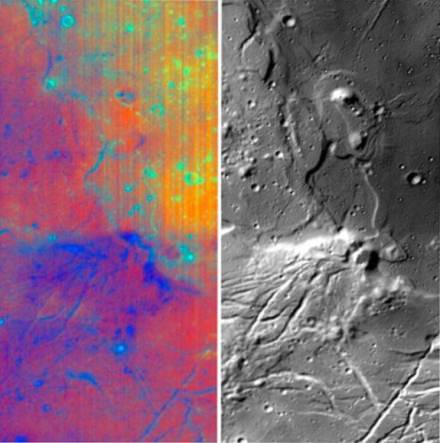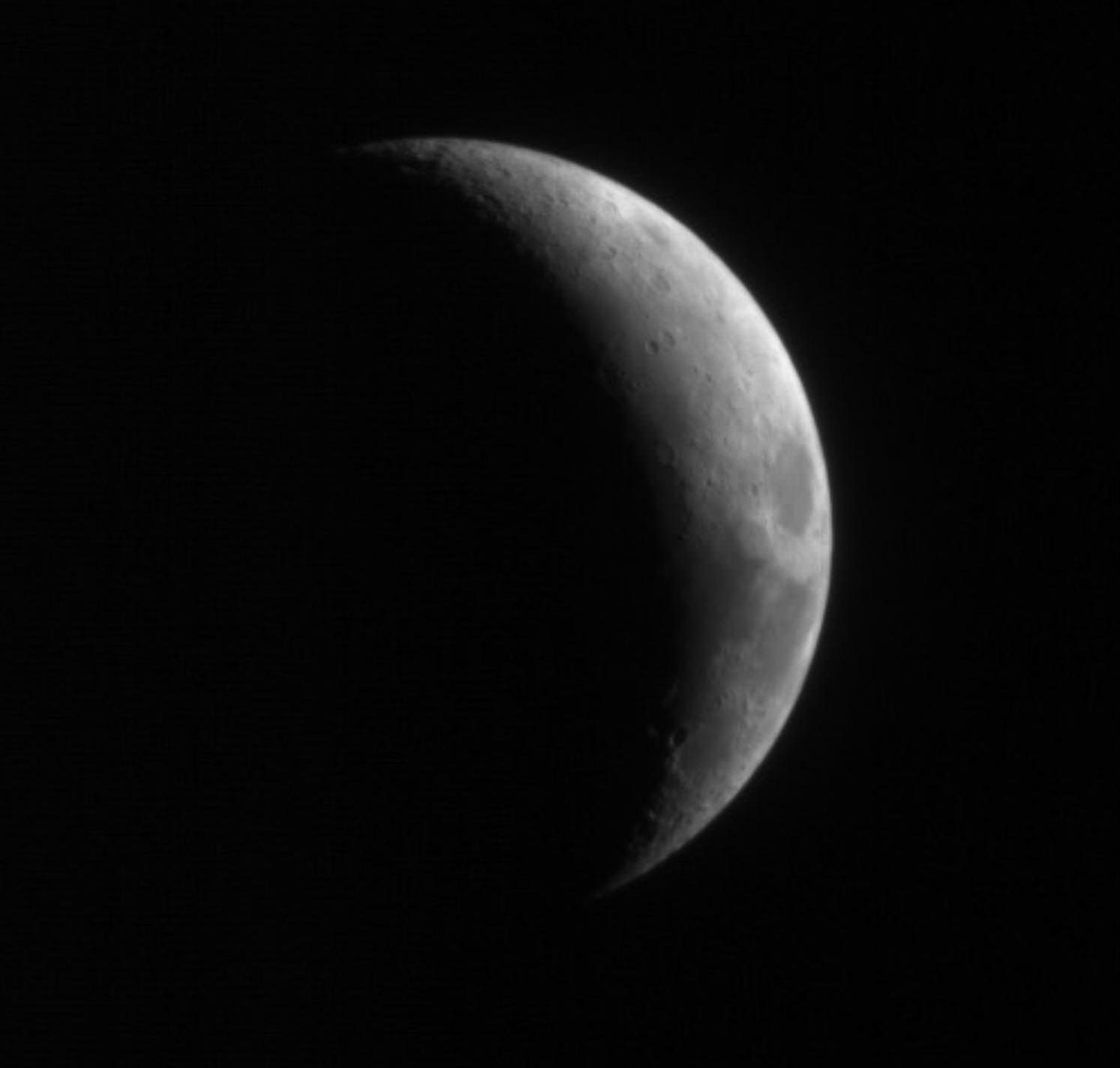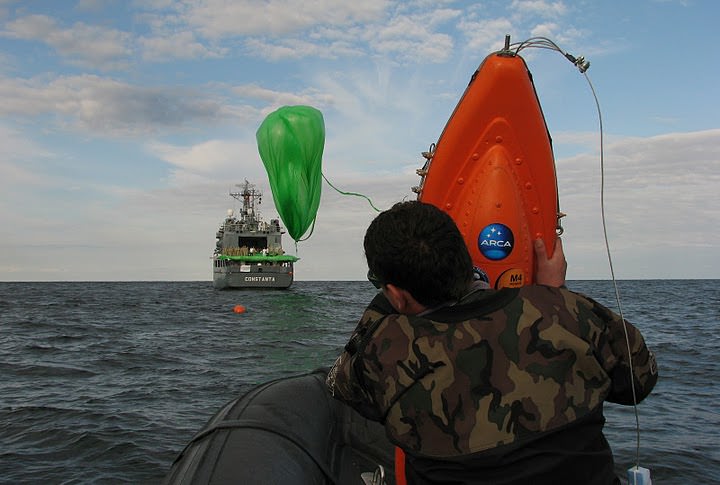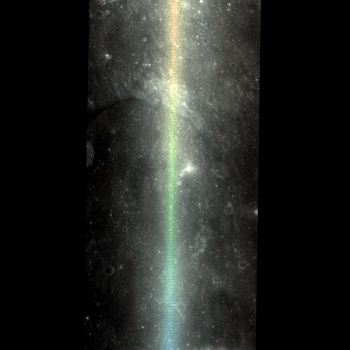Emily Lakdawalla at the Planetary Society blog unearthed some really cool videos taken by the Chinese Chang’E 2 spacecraft at the Moon. The five engineering videos include Chang’E 2’s solar panel deployment, orbit insertion burn, the first and second orbital trim maneuvers, and low lunar orbit. They are all especially unique in that the video not only includes images from the Moon’s surface, but also the spacecraft itself can be seen, providing a perspective that is not often seen. The video above is of Chang’E 2’s second orbit trim maneuver. Check out Emily’s post to see all five, plus she provides great insights into the video clips, as well.
Europa’s Tidal Processes Give Hints to Our Moon’s Far-side Bulge
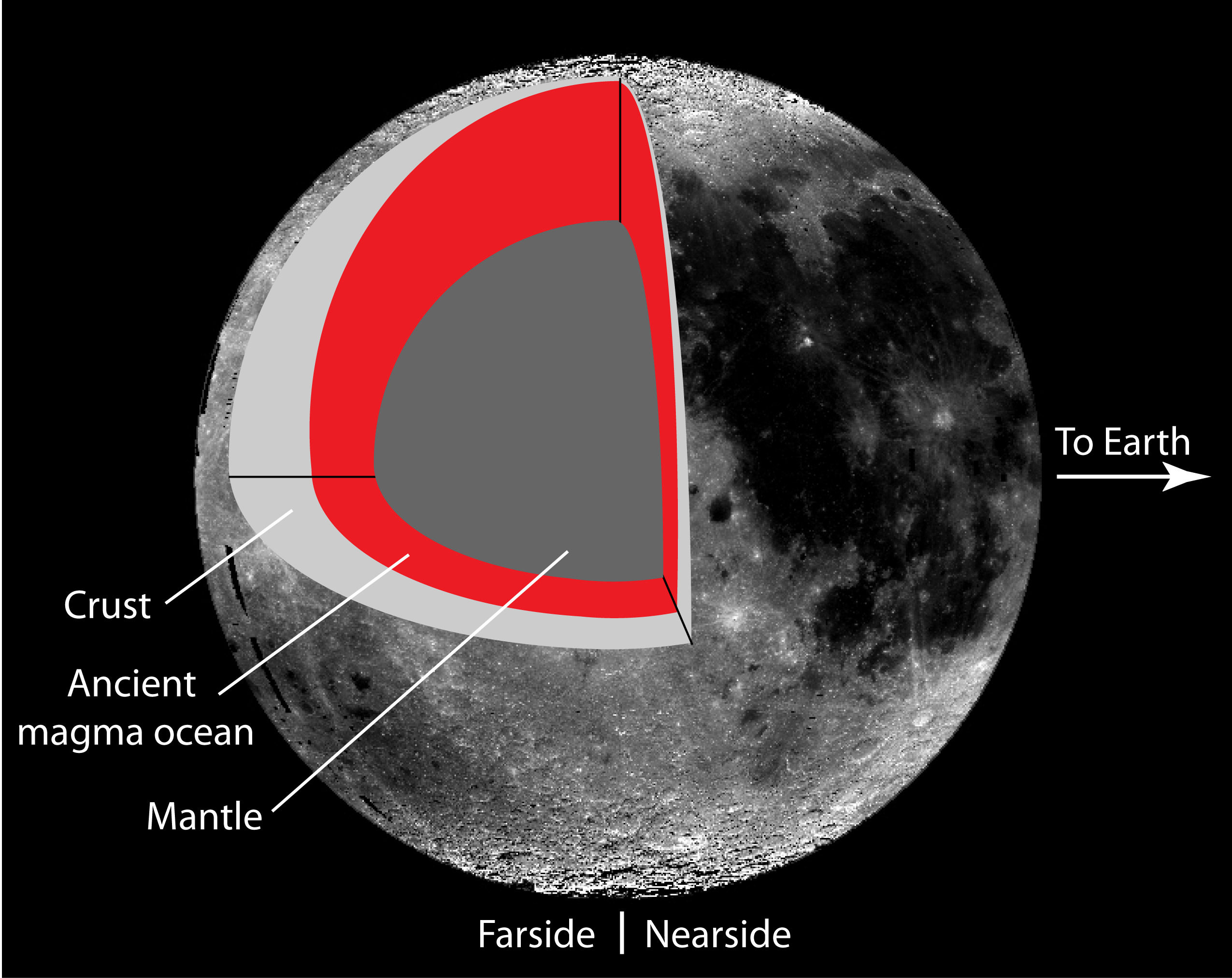
[/caption]
A self-conscious Moon might ask, “Does my far side look big?” To which lunar scientists would have to reply in the affirmative. They have long known there is a bulge on the Moon’s far side, a thick region of the lunar crust which underlies the farside highlands. But why that bulge is there has been a mystery, and the fact that the far side always faces away from Earth hasn’t helped. Now, a group of international scientists have found that perhaps the tidal processes of Jupiter’s icy moon, Europa, can provide a clue.
“Europa is a completely different satellite from our moon, but it gave us the idea to look at the process of tidal flexing of the crust over a liquid ocean,” said Ian Garrick-Bethell, the lead author of a new paper that offers an explanation for the lop-sided Moon.
Since the Apollo 15 laser altimeter experiment, scientists have known that a region of the lunar far side highlands is the highest place on the Moon. Additionally, the far side has only highlands and no maria.
Like Europa’s icy crust that sits over an ocean of liquid water, the Moon’s crust once floated on a sub-surface ocean of liquid rock. So, could the same gravitational forces from Jupiter that influence Europa also apply to the Earth’s influence on the early Moon?
Garrick-Bethell, from UC Santa Cruz, and his team found that the shape of the Moon’s bulge can be calculated by looking at the variations in tidal heating as the ancient lunar crust was being torn away from the underlying ocean of liquid magma.

With Europa in mind, the scientists looked at global topography and gravity data sets of the Moon, trying to determine the possibility of how about 4.4 billion years ago, the gravitational pull of the Earth could have caused tidal flexing and heating of the lunar crust. At the polar regions, where the flexing and heating was greatest, the crust became thinner, while the thickest crust would have formed in the regions in line with the Earth.
To back up their theory, they found that a simple mathematical function — a 2-degree spherical harmonics function — can explain the phenomenon. “What’s interesting is that the form of the mathematical function implies that tides had something to do with the formation of that terrain,” said Garrick-Bethell.

However, this doesn’t explain why the bulge is now found only on the farside of the Moon. “You would expect to see a bulge on both sides, because tides have a symmetrical effect,” Garrick-Bethell said. “It may be that volcanic activity or other geological processes over the past 4.4 billion years have changed the expression of the bulge on the nearside.”
Garrick-Bethell said his team hopes to continue to do more modeling and calculations to fully describe the far side’s features.
“It’s still not completely clear yet, but we’re starting to chip away at the problem,”he said.
The paper will be published in the November 12, 2010 issue of Science.
(Paper not yet available — we’ll post the link when it goes online).
First Images From Chang’E 2 Released
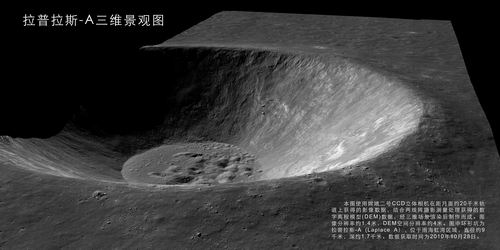
[/caption]
China’s space agency released the first images taken by the newest lunar orbiter, Chang’E 2. “The relaying back of the pictures shows that the Chang’e-2 mission is a success,” said Zhang Jiahao, director of the lunar exploration center of the China National Space Administration.
During its expected 6-month mission the orbiter will come within 15km above the surface, with the main mission of looking for potential landing for Chang’E-3, China’s next lunar mission that will send a rover to the Moon’s surface, scheduled for 2013. While all the other images are of Sinus Iridum (Bay of Rainbows), a rough translation of the writing on this top image has something to do with “antarctic,” so its possible this could be a crater near one of the lunar poles.
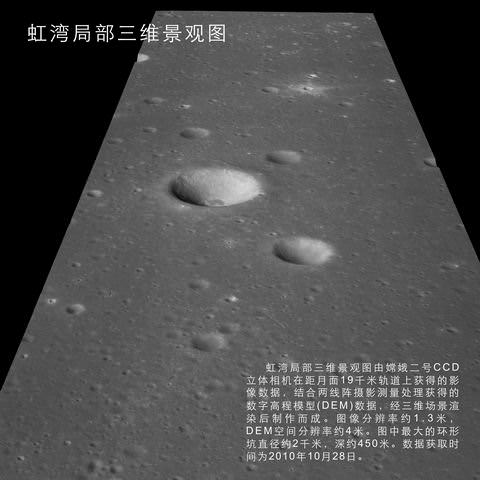
The data for this 3D image was taken by a the spacecraft’s stereo camera from 18.7 km on Oct. 28, four days after launch. The image has a resolution of 1.3 meters per pixel, more than ten times the resolution of pictures from Chang’E 2’s predecessor, Chang’E 1.
For comparison, NASA’s Lunar Reconnaissance Orbiter has a resolution of about 1 meter.
Sinus Iridum is considered to be one of the candidates for the 2013 lander.
Chang’E 2 will also test “soft landing” technology for the lander, which might mean that either the spacecraft is carrying an impactor or that the spacecraft itself will be crashed into the lunar surface like Chang’E 1.

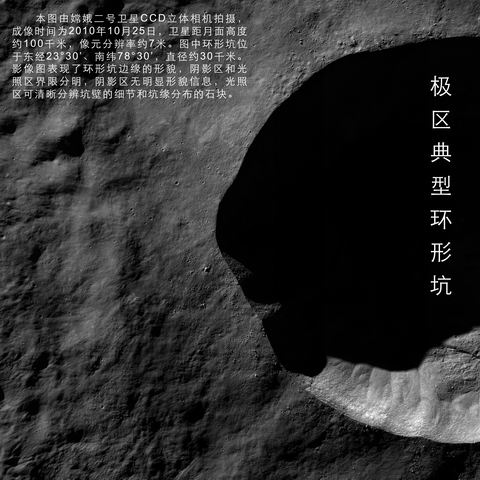
Sources: NASA Lunar Science Institute, China National Space Administration
Two New Kinds of Moon Rocks Found
[/caption]
Scientists analyzing data from the Moon Mineralogy Mapper instrument or M Cubed, on the Chandrayann-1 spacecraft found two different kinds of never-before-seen lunar rocks – one hidden in a basin on the far side of the Moon and the other staring right at us on the near side. Just four minerals — plagioclase feldspar, pyroxene, olivine, and ilmenite — account for 98-99% of the crystalline material of the lunar crust, but the composition of these newly found rocks are two different kinds of spinels, a magnesium spinel and a chromite spinel. The composition and location of these new rock types are extremely puzzling, and lunar scientists are trying to determine more details about these mysterious Moon rocks.
Universe Today talked with Dr. Carle Pieters from Brown University who is the Principal Investigator for M Cubed as well as Dr. Jessica Sunshine from the University of Maryland, a co- investigator with the project.
Universe Today: Dr. Pieters, tell us about the newly found rocks on the far side.
Dr. Carle Pieters: The rock type on the far side of the Moon that is so unusual is a magnesium spinel, which typically has iron, magnesium, and aluminum oxide. In looking in detail at the spectral properties of the Moscoviense Basin on the far side — and in particular the material along the inner-most ring of this basin — we noticed there were a few little areas that were spectroscopically unusual. So, of course we investigated those in more detail. We saw three primary different compositions, and two we understand and had seen elsewhere, and they are rich in iron bearing minerals called pyroxene and olivine, and we saw small areas of these that are widely separated.
But then the third kind of mineral, the magnesium spinel, we had never seen before on the Moon, and what is interesting is not only is there an unusual abundance of this particular mineral, but it also has a lack of the pyroxenes and olivines that we see elsewhere. So there are several mysteries that are interwoven here. One, is why do we have a concentration of this spinel mineral and however it got concentrated in this area, why aren’t the other minerals that we are familiar with also there, because they are not.
So this is a big mystery and it is a very exciting one because now we have to reexamine our understanding of the character of the lunar crust, in particular to the depths that might have been tapped by this enormous basin and that we are now looking at as exposed on the surface.
Universe Today: So, what does this tell you about this region on the Moon?
Pieters: Not only are these unusual areas compositionally, and they are only about a kilometer or two in size, but in every method we’ve been able to look at thus far, in every wavelength and resolution, they have no other distinguishing properties. Typically, on the Moon to indentify an usual composition we look for a fresh crater that has excavated and exposed material on the surface of the Moon. These areas have no fresh craters, no disturbance at all across their surface, even at the highest resolution that is seen with the LROC (Lunar Reconnaissance Orbiter Camera) instrument which measures a half a meter resolution.
These are old surfaces that have been undisturbed but have an extremely unusual composition. And even the space weathering that has occurred on the surface throughout the billions of years of history on the Moon has not erased their unusual compositions. So, they are unusual for the kind of compositions we see, but they are also unusual because they have no identifying property that allows us to identify them in our imagery which is quite unusual for features on the surface of the Moon.
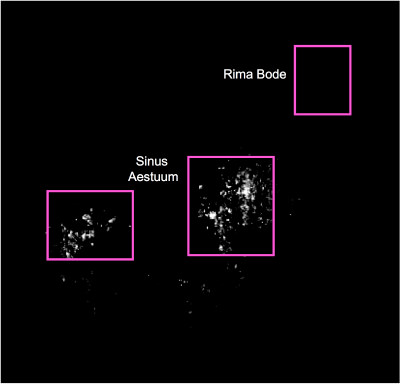
Universe Today: Now let’s move to the near side of the Moon, where Dr. Jessica Sunshine and her team went looking for unusual data.
Dr. Jessica Sunshine: One of the things I was asked to be in charge of was looking for anomalies, things that just didn’t look like the rest of the Moon. And of course you never know what’s going to happen under those circumstances. Carle had already discovered there seemed to be a magnesium spinel on the far side of the Moon and I went looking to see where else it could be. We found that the only place that we had anything that looked like the spinel mineral in the data we had was on the near side and it was an extremely large deposit in the middle of the central nearside, almost exactly dead center at zero-zero. And we started looking a little more carefully and realized that it wasn’t really the same kinds of things that Carle found, which truly was a new rock type on the far side of the Moon, but something really usual about the region.
We had already known the region was full of what we call dark mantle deposits or pyroclastic deposits, which is firefountaining deposits. This came from explosive eruptions of lava and gas over large areas of the Moon, about the size of Massachusetts. And we knew that three of them were there, it just turned out that one of them was compositionally different from the other ones, and in particular it had the kind of spinel which is a chromite, because it has chrome in it, and now we’re busy trying to figure out why this deposit is different from the one next door, and what does it mean. And we’re still working that process out as we speak.
Universe Today: What is it like to find something new like this on the side of the Moon that humans have been able to see for thousands of years?
Sunshine: Yes, I tend to title my talks on the subject something like, “Hidden in Plain Sight” because they are! It’s right there and I think this is a really fascinating part of this because we have been starring at the Moon, as humanity for millennia and if our eyes were slightly different we would see this one really dark spot in the middle of the Moon that is different from anywhere else.
Universe Today: What specifically about the Chandrayaan-1 spacecraft and the Mcubed instrument made these discoveries possible?
Sunshine: M Cubed collects data over a much broader range of light than our human eyes can. We can all see the rainbow, we’re all familiar with that, from blue to red, but there is light at shorter wavelengths, which we call ultraviolet, and particularly for this case, there is light at shorter wavelengths called infrared. M Cubed goes farther into the infrared than humans can see and it is there we are able to see diagnostic fingerprints of different kinds of minerals. So I suspect there are certain kinds of bugs who would look at the Moon and would have known these deposits are there because their vision goes into the infrared!
Universe Today: So, Dr. Pieters, does these new discoveries tell us there are still more mysteries to find on the Moon?
Pieters: Oh, absolutely! We’ve just barely scratched the surface here. This is thrilling from a spectroscapist’s point of view, of course, but also from someone who is trying to understand how planets work, and in particular how this wonderful small body in our neighborhood is telling us about the characteristics of crustal evolution and fundamental properties of planetary surfaces.
You can listen to a version of this interview on the 365 Days of Astronomy podcast and the NASA Lunar Science Institute podcasts
Understanding the Unusual LCROSS Ejecta Plume
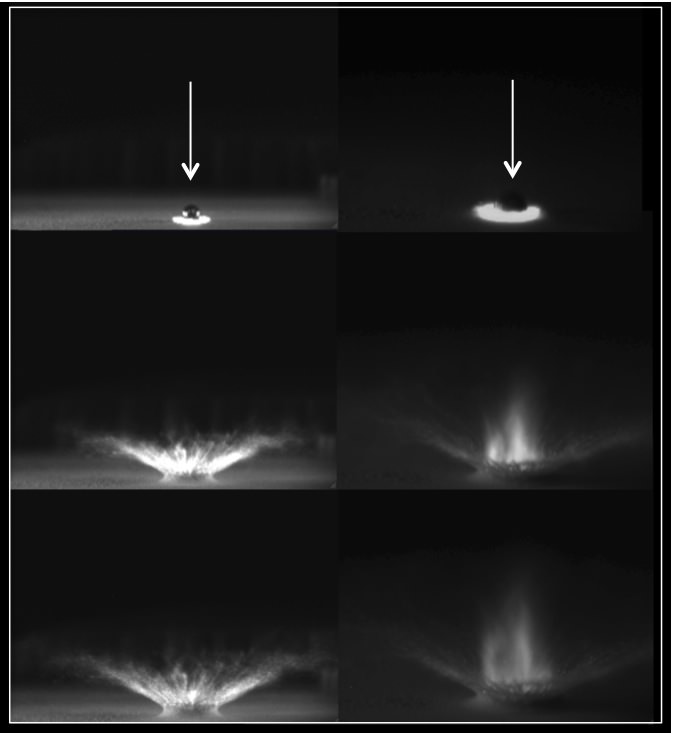
LCROSS was an unusual mission, in that it relied on an impact in order to study a planetary body. Not only was the mission unusual, so was the ejecta plume produced by slamming a hollow Centaur rocket booster into the Moon.
“A normal impact with a solid impactor throws debris out more than up, like an inverted lampshade that gets wider and wider as it goes out,” said Pete Schultz, from Brown University and a member of the LCROSS science team. “But the configuration of a hollow impactor — the empty rocket booster — created a plume that had both a low angle plume but more importantly, also a really prominent high angle plume that shot almost straight up.”
This high plume elevated the debris enough so it was illuminated by sunlight, and could be studied by spacecraft.
Even though the plume wasn’t seen from Earth, as was advertised prior to the impact, it was seen by the both the LCROSS shepherding spacecraft and the Lunar Reconnaissance Orbiter. Using the spent Centaur was not so much by mission design as using what was available. But it turned out to be a great choice.
“I think we were quite fortunate,” Schultz told Universe Today in a phone interview this week. “I think another design, and we may have gotten a very different result. Not much debris may have come up into the sunlight and the plume would have been very temporary.”
In order for the debris to get high enough to come into sunlight, it had to rise up about a half mile above the bottom of the crater.
“To put this into perspective,” said Schultz, “we had to throw debris up twice the height of the Sears Tower, the tallest building in the US. Now the Moon has less gravity, so if we bring it back down to Earth and compare it, it is like trying to throw a ball to the top of the Washington Monument. So there is a lot of gravity to overcome, and it turns out that this impact did it because we used a hollow impactor.”
When the rocket booster hit and the crater began to form, the lunar surface collapsed and shot upwards – almost like a jet – towards the sunlight, carrying with it the volatiles that had been trapped in the regolith.
In order to figure out what the impact was going to look like, Schultz and his team, which included graduate student Brendan Hermalyn, did small scale impacts and modeling. Their tests were only done a couple of months before the actual impact, and used small half-inch projectiles into different surfaces.
“Most impacts, when we model them, we assume the impactors are solid,” Schultz said. “We did experiments, with both solid and hollow projectiles, and when we used the hollow projectile, we had a real surprise. We not only saw the debris moving outward, but also upward.”
“We really didn’t know exactly what we were going to see in the actual LCROSS impact, but our tests explained a lot,” Schultz continued, “explaining why we saw what we did and why we saw the plume for such a long time. If it had been coming out like an inverted lampshade or a funnel expanding, the debris would have come up and gone back down, and probably would have been done within about 20 seconds. Instead, it just kept on coming.”
But there were some expected moments. As the LCROSS shepherding spacecraft approached the lunar surface, Tony Colaprete and the team readjusted the exposures on the cameras and the team was able to actually see the surface of the Moon in the final seconds before impact.
“That was great,” Schultz said. “That means we got to see the crater, we were able to get an estimate on how big the crater was, and it made sense with what our predictions had said. But we were also able to see the remnants of this high angle plume still returning to the surface. This must have been shot almost straight up into space, and was now coming back to the Moon. We saw it as a very diffuse cloud, and saw the remaining portions of the regolith coming back down, like a fountain. To me, that was the most exciting part.”
Schultz said he was nervous during the impact.
“I have to confess, we were on pins and needles,” he said, “as this was something much bigger than the experiments of using half inch projectiles and we didn’t know if it was going to scale up. We were dealing with something that looked like schoolbus with no children aboard that was slamming into the Moon and we didn’t know if that was going to behave in the same way as our smaller models.”
And even though the plume did act like the models, there were plenty of surprises — both in the impact and what has now been discovered to exist in Cabeus Crater.
“We knew when it was going to hit the surface – we know how fast how we were going and where we were above the surface — and it turned out there was a delay before we saw the flash and that was really a surprise,” Schultz said. “It was about a half second delay and then it took about a third of second delay before it began to rise and get brighter. The whole thing took seven-tenths of a second before it began to get bright. That is hallmark of a fluffy surface.”
Schultz said they know that it was likely a “fluffy” surface from the experiments and modeling, and from comparisons with the Deep Impact mission, for which he was a co-investigator.
“One of the first things we realized was that this is not your normal regolith — what you usually think of for the Moon,” Schultz said. “We watched the flash, and we looked for what type of spectra we saw. The spectra has the fingerprints of the composition of the elements and compounds. We were expecting because of the low speed we actually wouldn’t get to see much. But instead we immediately got a couple of hits, we got to see a sudden emission of OH, which is a characteristic at this wavelength of a byproduct of heating of water. Then the next 2-second exposure was when things started emerging, the overall spectra got brighter which meant we were seeing more dust. But then we saw this big giant peak of sodium, just like a beacon, a very bright sodium line.”
And then there were two other lines that were very odd. “The best association we could find that is was silver,” said Schultz. “That was a surprise. Then all these other emission lines started emerging as more material got into sunlight. This suggests that we were throwing the dust into the sunlight, and the volatiles that had been frozen in time, literally, in the shadows of Cabeus were heating up and and being released.”
Some of these compounds included not only water and OH, but also things like carbon monoxide, carbon dioxide, and methane, “things that we don’t think of when we talk about the Moon,” said Schultz. “Those are compounds we think of when we think about comets, so now we are in a position that maybe what we are seeing at the poles are the result of a long history of impacts that bring with them a lot of this type of material.” (Read our interview with Tony Colaprete for more about the recent LCROSS results.)
But no one is sure how the Moon can hold onto these volatiles and how they end up in the polar craters.
To figure that out, Schultz said more missions to the Moon are needed.
“Even though the Apollo astronauts were there, we’re now finding things 40 years later that are making our heads snap from all this the new information,” Schultz said. “It goes to show you, you can visit and think you know a place, but you have to go back and maybe even live there.”
Schultz said that as an experimentalist, one can never feel smug, but seeing how the actual plume behaved just like their models, he and his team were very happy. “Experiments are letting nature teach you lessons and that is why they are very interesting to do. We are humbled almost daily.”
Water on the Moon and Much, Much More: Latest LCROSS Results

[/caption]
A year ago, NASA successfully slammed a spent Centaur rocket into Cabeus Crater, a permanently shadowed region at the lunar South Pole. The “shepherding” LCROSS (Lunar Crater Observation and Sensing Satellite) spacecraft followed close on the impactor’s heels, monitoring the resulting ejecta cloud to see what materials could be found inside this dark, unstudied region of the Moon. Today, the LCROSS team released the most recent findings from their year-long analysis, and principal investigator Tony Colaprete told Universe Today that LCROSS found water and much, much more. “The ‘much more’ is actually as interesting as the water,” he said, “but the combination of water and the various volatiles we saw is even more interesting — and puzzling.”
The 2400 kg (5200 pound) Centaur rocket created a crater about 25 to 30 meters wide, and the LCROSS team estimates that somewhere between 4,000 kilograms (8,818 pounds) to 6,000 kilograms (13,228 pounds) of debris was blown out of the dark crater and into the sunlit LCROSS field of view. The impact created both a low angle and a high angle ejecta cloud. (Read more about the unusual plume in our interview with LCROSS’s Pete Schultz).
The LCROSS team was able to measure a substantial amount of water and found it in several forms. “We measured it in water vapor,” Colaprete said, “and much more importantly in my mind, we measured it in water ice. Ice is really important because it talks about certain levels of concentration.”
With a combination of near-infrared, ultraviolet and visible spectrometers onboard the shepherding spacecraft, LCROSS found about 155 kilograms (342 pounds) of water vapor and water ice were blown out of crater and detected by LCROSS. From that, Colaprete and his team estimate that approximately 5.6 percent of the total mass inside Cabeus crater (plus or minus 2.9 percent) could be attributed to water ice alone.
Colaprete said finding ice in concentrations – “blocks” of ice — is extremely important. “It means there has to be some kind of process by which it is being enhanced, enriched and concentrated so that you have what is called a critical cluster that allows germ formation and crystalline growth and condensation of ice. So that data point is important because now we have to ask that question, how did it become ice?” he said.
In with the water vapor, the LCROSS team also saw two ‘flavors’ of hydroxyl. “We saw one that was emitting as it if it was just being excited,” Colaprete said, “which means this OH could have come from grains — it could be the adsorbed OH we saw in the M Cubed data, as it was released or liberated from a hot impact and coming up into view. We also see an emission from OH that is called prompt emission, which is unique to the emission you get when OH is formed through photolysis.”
Then came the ‘much more.’ Between the LCROSS instruments, the Lunar Reconnaissance Orbiter’s observations – and in particular the LAMP instrument (Lyman Alpha Mapping Project) – the most abundant volatile in terms of total mass was carbon monoxide, then was water, the hydrogen sulfide. Then was carbon dioxide, sulfur dioxide, methane, formaldehyde, perhaps ethylene, ammonia, and even mercury and silver.
“So there’s a variety of different species, and what is interesting is that a number of those species are common to water,” Colaprete said. “So for example the ammonia and methane are at concentrations relative to the total water mass we saw, similar to what you would see in a comet.”
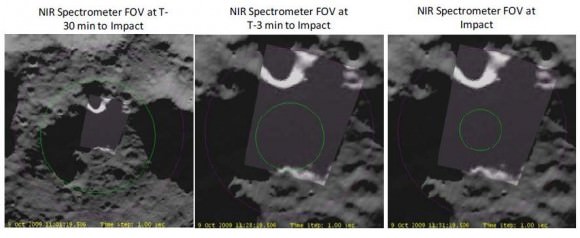
Colaprete said the fact that they see carbon monoxide as more abundant than water and that hydrogen sulfide exists as a significant fraction of the total water, suggests a considerable amount of processing within the crater itself.
“There is likely chemistry occurring on the grains in the dark crater,” he explained. “That is interesting because how do you get chemistry going on at 40 to 50 degrees Kelvin with no sunlight? What is the energy — is it cosmic rays, solar wind protons working their way in, is it other electrical potentials associated with the dark and light regions? We don’t know. So this is, again, a circumstance where we have some data that doesn’t make entirely a lot of sense, but it does match certain findings elsewhere, meaning it does look cometary in some extent, and does look like what we see in cold grain processes in interstellar space.”
Colaprete said that finding many of these compounds came as a surprise, such as the carbon monoxide, mercury, and particularly methane and molecular hydrogen. “We have a lot of questions because of the appearance of these species, “ he said.
There were also differences in the abundances of all the species over the time – the short 4 minutes of time when they were able to monitor the ejecta cloud before the shepherding spacecraft itself impacted the Moon. “We actually can de-convolve, if you will, the release of the volatiles as a function of time as we look more and more closely at the data,” he said. “And this is important because we can relate what was released at the initial impact, what was released as grains sublimed in sunlight, and what was “sweated out” of the hot crater. So that’s where we’re at right now, it’s not just, ‘hey we saw water, and we saw a significant amount.’ But as a function of time there are different parts coming out, and different ‘flavors’ of water, so we are unraveling it to a finer and finer detail. That is important, since we need to understand more accurately what we actually impacted into. That is really what we are interested in, is what are the conditions we impacted into, and how is the water distributed in the soil in that dark crater.”
So the big question is, how did all these different compounds get there? Cometary impacts seem to offer the best answer, but it could also be outgassing from the early Moon, solar wind delivery, another unknown process, or a combination.
“We don’t understand it at all, really,” Colaprete said. “The analysis and the modeling is really in its infancy. It is just beginning, and now we finally have some data from all these various missions to constrain the models and really allow us to move beyond speculation.”
LCROSS was an “add-on” mission to the LRO launch, and the mission had several unknowns. Colaprete said his biggest fear going into the impact and going into the results was that they wouldn’t get any data. “I had fears that something would happen, there would be no ejecta, no vapor and we’d just disappear into this black hole,” he confessed. “And that would have been unfortunate, even though it would have been a data point and we would have had to figure out how the heck that would happen.”
But they did get data, and in an abundance that — like any successful mission — offers more questions than answers. “It really was exploration,” Colaprete said. “We were going somewhere we had absolutely never gone before, a permanently shadowed crater in the poles of the Moon, so we knew going into this that whatever we got back data-wise would probably leave us scratching our heads.”
Additional source: Science
Why Can We See the Moon During the Day?
We all know the basics of the Diurnal Cycle – day and night, sunrise and sunset. And we are all aware that during the day, the Sun is the most luminous object in the sky, to the point that it completely obscures the stars. And at night, the Moon (when it is visible) is the most luminous object, sometimes to the point that it can make gazing at the Milky Way and Deep-Sky Objects more difficult.
This dichotomy of night and day, darkness and light, are why the Moon and the Sun were often worshiped together by ancient cultures. But at times, the Moon is visible even in the daytime. We’ve all seen it, hanging low in the sky, a pale impression against a background of blue? But just what accounts for this? How is it that we can see the brightest object in the night sky when the Sun is still beaming overhead?
Flying to the Moon — From the Space Station?
[/caption]
Last month the International Space Station partner agencies met to discuss the continuation of space station operations into the next decade and its use as a research laboratory. They also did a little forward thinking, and talked about some unique possibilities for the station’s future, including the potential for using the space station as a launching point to fly a manned mission around the Moon. I don’t know what our readers think, but my reactions is: this is just about the coolest idea I’ve heard in a long while! I’m having visions of a Star Trek-like space-dock, only on a smaller scale! In an article by the BBC’s Jonathan Amos, the partners said they want the ISS to become more than just a high-flying platform for doing experiments in microgravity, but also hope to see it become a testbed for the next-generation technologies and techniques needed to go beyond low-Earth orbit to explore destinations such as asteroids and Mars.
“We need the courage of starting a new era,” Europe’s director of human spaceflight, Simonetta Di Pippo, told the BBC News. For sending a mission to the Moon from the ISS, De Pippo said, “The idea is to ascend to the space station the various elements of the mission, and then try to assemble the spacecraft at the ISS, and go from the orbit of the space station to the Moon.”
One “next-generation” activity that is already planned is conducting a flight test of the Variable Specific Impulse Magnetoplasma Rocket (VASIMR) engine on the ISS, which is the new plasma–based space propulsion technology, that could get astronauts to destinations like Mars much quicker than conventional rockets. NASA has sign a commercial Space Act with the Ad Astra company (which is lead by former astronaut Franklin Chang Diaz).
But starting a Moon mission from the ISS is really a far-reaching, kind of “out-there” concept. It would be reminiscent of Apollo 8, and be the first of a new philosophy of using the station as a spaceport, or base-camp from where travelers start their journey. The propulsion system would be built at the station then launched from orbit, just like space travelers have dreamed for decades.
Of course, this is just an idea, and probably an expensive proposition, but isn’t it wonderful that the leaders of the space agencies are even thinking about it, much less talking about it?
Of course, doing zero-g experiments would always be the main focus of the ISS, but just think….
With this type of mission, the future of spaceflight actually be as Canadian astronaut Chris Hadfield describes in the video below. “This is the great stepping off point of to the rest of the universe,” says Hadfield, who will be commanding an upcoming expedition on the ISS. “This is an important moment in the history of human exploration and human capability,… and the space station is a visible sign of the future to come.”
Read more about the idea of an ISS-based Moon mission at BBC.
Moon Balloon Has Mostly Successful Test Flight
[/caption]
A Romanian team aiming to send a rocket to the Moon via balloon successfully launched a test flight of their Helen 2 rocket, sending the first Romanian-made rocket system to 40,000 meters above the Earth. The Aeronautics and Cosmonautics Romanian Association (ARCA) team is vying for the Google Lunar X PRIZE, and tested the balloon/rocket system (sometimes called a ‘rockoon’) which launched from a Romanian naval frigate from the Black Sea. While the balloon and rocket worked great, the parachute and recovery system failed. But the team met their main objectives and were ecstatic.

ARCA has a simple, “green” design. For getting the Moon, a super-huge balloon will carry a system of three rockets to about 18 km (11 miles). Then the first two rocket stages will fire and boost the system into low Earth orbit, and use the final stage to boost it to the Moon. The lander, the European Lunar Explorer (ELE) resembles a knobby rubber ball that uses its own rocket engine to ensure a soft landing. They consider their system to be green, as the rocket engine operates exclusively with hydrogen peroxide
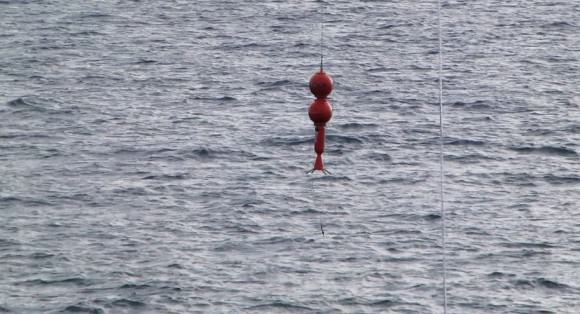
The balloon ascent took 40 minutes, bringing the system to an altitude of 14,000 m, at times raising the system at 120 km/h. When it reached that altitude, the flight controllers on the naval ship lit the rocket engines for 30 seconds, bringing it to 40,000 meters. From flight data transmitted to the control centers of ARCA and the Romanian civil aviation authority (ROMATSA) the team was able to confirm the successful flight trajectory, which had an error of only 800 m from the center of their safe trajectory.
A payload on board the capsule took pictures from the top of the trajectory.
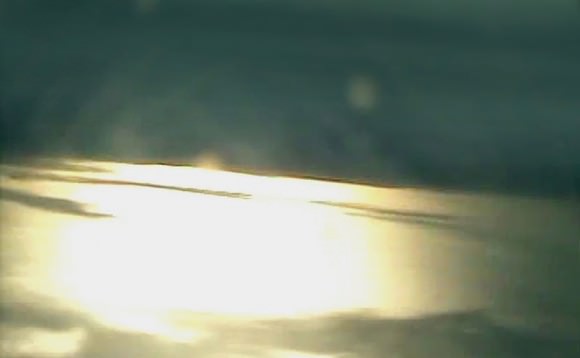
But at the capsule’s reentry, the parachute did not open, and a ship sent to try and find the capsule in the water was not able to find and retrieve it. But the ARCA team said they didn’t look for it for very long, since most data were transmitted by radio telemetry and satellite and recovery isn’t an objective of the Google Lunar X Prize Competition.
However, they were able to complete the successful launch of the first Romanian space rocket, as well as their first flight of the Google Lunar X Prize Competition. They also verified their rocket stabilization system, and reached the highest altitude ever by an object designed and built entirely in Romania.
In November 2009, ARCA’s test flight hopes were dashed when the balloon’s lines became entangled during inflation and had to be cut, and the test curtailed.
Rockoons were tried and then abandoned by the US in the 1950s because they blew off course in windy conditions.
Watch a video animation of the test flight:
See more images of the test flight at ARCA’s Picasa page.
Source: ARCA
A Rainbow Across the Moon
[/caption]
Even though it is not the mind-blowing experience of a double rainbow all the way across the sky, seeing a rainbow on the Moon is pretty unusual. This curious image from the Lunar Reconnaissance Orbiter shows a rainbow effect across 120 km of the lunar surface. And although water has recently been found on the Moon, water droplets have nothing to do with this rainbow. It comes from illumination conditions and viewing angles with having the Sun directly overhead of the LRO and the Moon.
“This image was acquired as the Sun was exactly overhead, allowing us to observe the ‘opposition surge,’said Brent Denevi, writing on the LRO Camera website. “This is a surge in brightness that occurs when the Sun is directly behind the observer because of two effects. First, there are no shadows seen on the surface, because each boulder and grain of soil’s shadow is hidden directly beneath it. Second, as the light reflects back to the observer it constructively interferes with itself.”
It is a very cool effect, giving the Moon a look having some unexpected color. Denevi said images that contain this type of effect are not just pretty, but useful, too. “They provide a huge new dataset for studying how light interacts with a particulate surface at different wavelengths,” he said. “Perhaps an esoteric-sounding field of study, but this data can help us understand the reflectance images and spectra we have of the Moon and other bodies throughout the Solar System.”

